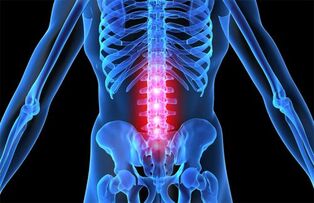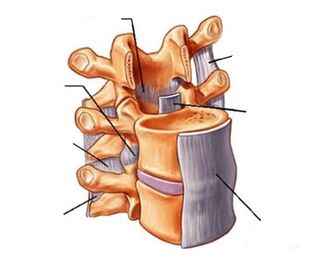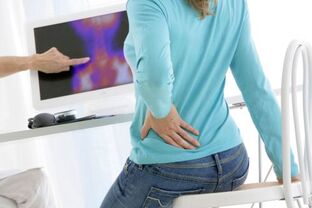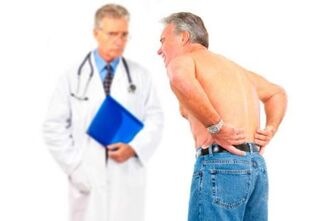A significant mass of a person falls on their lower back, and when the load is lifted, twisted, from a long static position, additional tension is created. Excessive stress, wrong lifestyle constantly lead to a deterioration in the musculoskeletal system: the vertebrae and intervertebral discs between them, which act as shock absorbers. From this point on, it is worth looking for information about lumbar spine osteochondrosis: symptoms and treatment. Why is there a deterioration in the spinal joints?

The musculoskeletal system breaks down as follows: The natural shock absorber of the spine loses its elasticity, shrinks, spreads beyond its natural limits, and the pressure from other vertebrae, organs and ligaments also increases. Let's describe those who tend to acquire such a pathology. Lumbar spine osteochondrosis can be seen in humans:
- Whose early generations suffered from a similar ailment;
- have hormonal disorders;
- Individual tendency to develop such diseases (e. g. innate structure of the spine);
- Those who neglect proper nutrition. On the table, a person should receive a balanced diet with healthy fats, vitamins and proteins every day;
- Those who have a sedentary job: sitting for a long time or standing in one place for a long time;
- Experiencing a sharp and heavy load on the spine, for example: weightlifters, loaders, people while gardening;
- Digestive, metabolic and pelvic diseases;
- Traumatized (pulled too tight on the back, hit sideways, fallen, bent over);
- have reached the age of 30;
- diabetes.
If there are signs of lumbar osteochondrosis, which are described in the following section, there are a few habits to avoid:
- slouch;
- smoke;
- takes a curled pose for a long time;
- move a little;
- drink alcohol;
- sit without taking breaks from work;
- Don't dress for the weather, let the body cool off.
Important. Disturbances in the ligaments are exacerbated by the presence of excess weight. With obesity, the burden on the lower body increases and the lumbar region, which is overgrown with fat, is heavily massaged.
Stages of the course of the disease, its signs

First of all, there is periodic slight pain that increases with physical exertion. This discomfort suggests that it is time to pay attention to the lumbar spine osteochondrosis. At the moment, the intervertebral discs are deteriorating (the spinal disc is the canal through which the spinal cord and the fibrous ring around it are formed). It also narrows the distance between the vertebrae, pinching the nerves. The pain becomes severe, affects not only the back, but also the hips, gluteal muscles. In the third stage, the rings of fibers are destroyed, which leads to the formation of an inguinal hernia, irreversible flexion and constant pain. The fourth stage leads to a disability. The special classification of osteochondrosis of the lumbar spine includes:
- pain;
- ischemic syndrome;
- radicular syndrome;
- vertebral syndrome;
- Ossification of overgrown tissue.
Pain sensations vary in severity and character: lumbago is called, for example, lumbago; constant, aggravated by stress, lumbodynia; The spread along the lower parts of the body is known as lumbar sciatica. If back disorders are not treated, the vertebrae get too much free movement in the spine. When lifting loads and abrupt actions, there is compression of the nerve roots, then the pain leaves the lower back, but travels to other parts of the body for which the nerve is responsible. We subconsciously change position and adjust so that there is less pain in the back, but at the same time the gait and spinal flexion inevitably change. All of this is related to radicular syndrome, which starts out as irritation and then becomes inflammatory. Signs of lumbar spine osteochondrosis with radicular syndrome:
- The back muscles are excessively tired.
- Change of the reverse curve;
- gait changes;
- swelling of the lower extremities;
- pain in one or both legs;
- severe pain;
- temporary loss of leg sensitivity;
- periodically long constipation;
- Men have problems with excitability;
- menstrual disorders in women;
- poisoning the body;
- Blood stagnation.
You may notice that painful sensations appear during the breaks and that they subside when doing exercises on the back. Even at this stage, it is worth visiting a doctor: a chiropractor, surgeon, neurologist, traumatologist (since the causes of osteochondrosis of the lumbar spine are trauma). If you let the disease take its course, the problem will increase, supplemented by various companions:
- warmth;
- deafness;
- sweat;
- tingling;
- chills;
- goose bumps;
- impotence;
- intestinal colic.
Back muscles lose their tone and this leads to a general loss of human motor skills. With a particularly dangerous course of the radicular syndrome, paralysis occurs. Ischemic syndrome is associated with radicular. At first, the squeezing of the blood flow is periodic, but then such squeezing leads to convulsions. You can notice them while walking normally - you walk in pain, when you stop it doesn't hurt. The main breakdown takes place inside and is not visible to the naked eye - the blood streams do not provide all pelvic organs with the necessary supply. You may experience pain in your buttocks and thighs, and then you may experience paralysis of your glutes. The vertebral syndrome involves a change in the skeleton, the blood vessels themselves.
Important. Symptoms of lumbar osteochondrosis in women are inextricably linked to hormone levels and the physiological properties of the body. The occurrence of pain and incorrect posture is affected by wearing unsuitable shoes: soles that are too hard or too soft; too high heel or too low heel.
Diagnosis of the stages of the disease

Even for a doctor, it can be very difficult to classify and name the stage of the disease during the external examination. First, a neurologist can diagnose:
- persistent curvature of the spine;
- pain when touching;
- decreased leg movement;
- asymmetry of the buttock zone;
- Change Michaeli's diamond.
However, the most accurate diagnosis can only be made with the following results:
- Computed tomography (CT). The most optimal option for determining the degree of development of the disease, which can be used to assess the stage of degradation of the spine.
- X-rays. According to it, it is possible to determine the presence of a disease, but it is not always possible to determine the degree of development of damage to nerve fibers and blood vessels.
- magnetic resonance imaging. Quite a long (from half an hour to an hour), expensive procedure that also gives the most complete details of what happens to the nerve roots and blood vessels.
Thus the doctor can finally assess the osteochondrosis of the lumbar spine: Symptoms and treatment only with the results of the device research. Lower back pain that is not associated with an injury to the intervertebral disc is caused by a cold, kidney cold, menstrual cycle, or back muscle pain.
Important. CT and X-rays are not acceptable for pregnant women. CT is unsafe for: 1) children under 14 years of age; 2) people with iodine allergy.
Medical treatment
The causes of the onset of the disease, its characteristics were considered above. Let us now come to the second point of lumbar spine osteochondrosis: symptoms and treatment. The longer you ignore the body's signals, the faster the disease will progress. The further from the beginning, the more drugs and procedures must be used. Treatment goals:
- identify, eliminate the causes of pinching the roots, blood vessels of the spine;
- restores the sensitivity of the skin;
- to prevent the further development of the pathology;
- starts the body's self-healing processes;
- strengthening a person's muscle tone;
- restores the function of the internal organs of the small pelvis;
- returns the normal course of the lumbar vertebrae.
If you have any symptoms, contact your doctor. The first thing to do at the first symptoms is to consider the following: a bed (a wide variety of orthopedic mattresses that must be selected individually), a pillow (may not be suitable in size or softness), sleeping position, motor activity. At home, lumbar spine osteochondrosis is treated only with bed rest without a medical examination. Therefore, a doctor's visit is mandatory. Various drugs are taken at the stage of remission and in the acute phase of the disease. In the final phase, drugs are used to relieve pain, rid nerves of vertebral mites, and clear inflammation. Prescribe: - blockades, - glucocorticoids, - chondroprotectors, - myo-laxatives, - non-steroidal anti-inflammatory drugs (NSAIDs).

The last group of drugs, in addition to pain relief, fights with excessive body temperature, edema and inflammation. Such means can be: rectal, for internal use, injection, external. Treatment for lumbar spine osteochondrosis most commonly begins with NSAIDs:
- diklofenac;
- piroksikam;
- ibuppofen;
- himeculide;
- hapoxy;
- decketoprofen;
- Meloksikam;
- Aceclofenac.
The anti-inflammatory drugs on this list are various ointments, tablets, gels. Some tablet NSAIDs have contraindications for people with ulcers or gastritis. Muscle relaxants relieve joint stiffness and involuntary contractions of the back muscles by temporarily reducing muscle tone. This group of drugs includes tizanidine, tolperisone hydrochloride. If it is possible to save the intervertebral disc, chondroprotectors are prescribed, which are intended to restore the annulus fibrosus. The course of taking such a group of drugs is very long - at least 1, 5 months, and the results are visible only after a year. They try to avoid the appointment of glucocorticoids as they cause side effects when taking them, since this group of drugs belongs to steroid hormones. They must be taken under the supervision of the attending physician, complying with all the prescriptions, since only a specialist knows how to cure lumbar osteochondrosis. An example of such a drug is hydrocortisone. Blockages are not drugs in and of themselves, but they are a powerful local pain reliever. The technique is as follows: Introduction of an injection pain reliever (IO) or a combination of IO with a drug from the group of glucocorticoids in the pain area. Blockages have no medicinal properties, but can be addictive, resulting in a loss of sensitivity to these drugs. If the injection is frequent, the muscles around the injection may atrophy. Therefore, with the reduction in acute pain from this method of treatment, the patient is prescribed drugs designed to restore damaged tissue and blood circulation, as well as improve muscle and nerve fiber tone. This:
- The chondroprotectors, which have a general strengthening effect on bone tissue, normalize the metabolism of cartilage tissues.
- Vitamins that help restore nerve patency.
- Biogenic preparations that encourage the body to heal itself;
- vascular drugs that thin the blood to improve the nutrition of the internal organs.
During treatment, in addition to the main intake of drugs, antidepressants are prescribed. How to treat lumbar osteochondrosis while reducing acute pain:
- apply warming, analgesic and anti-inflammatory external agents;
- do special exercises for the back;
- go for a massage;
- leads a gentle lifestyle for the back;
- Put on a belt corset when exercising.
Massage, exercise therapy, physiotherapy and alternative treatments.

Comparatively cheap and effective methods of combating the degradation of shock absorbers are physiotherapy exercises, massages and physiotherapy. A real massage can only be done by a professional with medical training, so a simple visit to beauty salons is not suitable for patients. Each stage of the disease requires a different pressure and technique. With proper therapy, the muscle spasm disappears, the muscular frame of the back is strengthened, and the pain gradually disappears. Physiotherapy is applicable only when painful processes are weakened or when they are absent (to maintain the mobility of the vertebrae). Gymnastics is selected individually based on the age, condition of the person and the stage of development of the disease. The productivity of therapeutic exercises directly depends on the quality of performance and frequency: they must be performed systematically. It is recommended to rest at home, lie on your back, bend your legs and put a small roll under your lower back. The healing process is monitored with the help of X-ray examinations. Physiotherapy treatments are prescribed during remission and exacerbation. Methods like:
- acupuncture. An ancient method of pain management based on the stimulation of acupuncture points with fine needles. The procedure relieves spasms, relieves pain, completely eliminates it and reduces tissue edema.
- ultraviolet radiation, which stimulates the body to absorb calcium;
- Ampilpus, named after the corresponding device. The treatment procedure is as follows: the plates of the device are fixed on the back, and the corresponding therapeutic current with different parameters flows through the plates;
- laser therapy. Laser beams relieve pain, heal, stop inflammation in the lumbar vertebrae;
- darsonvalization. The method is said to improve blood circulation, widen blood vessels and stimulate nerve endings.
- The phonophoresis is treated with ultrasound and stimulates the blood flow to the muscular part of the back region.
Each method has its own contraindications. It's more difficult with traditional medicine. Official medicine still does not recognize that midwives' grandmothers know how to treat lumbar osteochondrosis. If a friend advises you to apply compresses made with burdock broth and take needle baths, it is worth consulting your doctor. A method such as hirudotherapy is used to relieve pain, but leeches are hidden behind this name. Therefore, doctors advise using this method of treatment with caution.
Surgical problem solving
In some cases an operation is no longer possible. For advanced intervertebral hernias, neurosurgeons use a microdiscectomy. The process removes the damaged hard drive. If there are no contraindications, doctors can perform nucleoplasty, which has many advantages:
- Does not require cuts;
- The process takes up to 30 minutes.
- No restrictions on surgical interventions.
Important. In order to maintain the mobility of the spine and strengthen the back muscles, it is recommended to do yoga, swimming and Pilates. When running, there is a shock load on the vertebrae. At the first sign of back pain, jogging should be stopped.















































